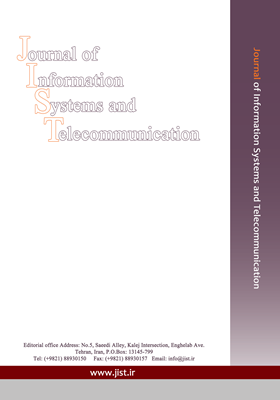Standard Deviation Characterization of a Small Size Reverberation Chamber by Using Full-wave Simulation and E-Field Probe
Subject Areas : Electromagnetic, Antenna and PropagationEhsan Poodineh 1 , Farhad Ghorbani 2 , Reza Asadi 3 , Hadi Aliakbarian 4
1 - KN Toosi University of Technology
2 - KN Toosi University of Technology
3 - KN Toosi University of Technology
4 - KN Toosi University of Technology
Keywords: Reverberation chamber, , stirrer, , Electromagnetic Compatibility tests, , Antenna gain and efficiency, , standard Deviation, ,
Abstract :
Reverberation Chamber (RC) is a new type of measurement equipment used in electromagnetic compatibility and antenna tests and capable to produce an almost uniform electric filed inside a Working Volume (WV). In this paper, the field uniformity of an actual small size RC is studied. At first, the mode density of the chamber which should be larger than unity is investigated. In the next step, the Standard Deviation (SD) of a small size RC, as a field uniformity criterion is investigated in an existing RC. A highly detailed three-dimensional model of chamber including its stirrers, antenna, WV, and its door create to verify the field uniformity of a RTS60 reverberation chamber. The removal of reverberation chamber’s stirrers shows that they have a direct effect on the uniformity of field. As the stirrer moves during the test, the effect of three different position of stirrer on the field uniformity is investigated. The transmission antenna, as an important component of these rooms, is simulated and investigated separately. The reflection coefficient of that antenna fit the working frequency band of the chamber. In a real scenario, the SD of the chamber is measured by using an electric field probe. A comparison between the simulation and measurement also is done in order to confirm the uniformity of the electric fields.
[1].Leach, R. and M.B. Alexander, Electronic systems failures and anomalies attributed to electromagnetic interference. , is presented at the space programs and Technologies conference,alabam1995.
[2].Stephenson, J.H., D. Weitsman, and N.S. Zawodny, Effects of flow recirculation on unmanned aircraft system (UAS) acoustic measurements in closed anechoic chambers. The Journal of the Acoustical Society of America, 2019. 145(3): p. 1153-1155.
[3].Smith, K.M., A homogeneous RF-shielded magnet for low-field magnetic resonance studies," MASTER OF SCIENCE, Department of Physics and Astronomy, in Winnipeg, Manitoba. 2019, The University of Manitob: canada.
[4].J. W. Hansen, E.M.S., J. D. Cleveland, S. M. Asif, B. Brooks, B. D. Braaten, A Systematic Review of In-vitro and in Vivo Radio Frequency Exposure Methods. IEEE reviews in biomedical engineering, 2019.
[5].Vinci, J.J., Sparse Aperture Measurement in a Non-Ideal Semi-Anechoic Chamber., University of Dayton United States,2019.
[6].Dubey, S.K. and V. Ojha, Numerical Analysis and Measurement of Electric field Strength inside GTEM Cell at GSM Frequencies. Defence Science Journal, 2019. 69(5): p. 423.
[7].A.Sahraei, H.A., On the Design and Fabrication of a Large GTEM Cell and its Challenges. to be published in IEEE EMC Magazine, 2020.
[8].A. K. Fall, P.B., C. Lemoine, M. Zhadobov, and R. Sauleau, Design and experimental validation of a mode-stirred reverberation chamber at millimeter waves. EEE Transactions on Electromagnetic Compatibility, 2014. vol. 57: p. pp. 12-21.
[9].States, U., A document that establishes uniform engineering and technical requirements for military-unique osubstantially modified commercial processes, procedures, practices, and methods. 1999. p. pp. 707-710.
[10].Compatibility, E., Part 4-21: Testing and measurement techniques—reverberation chamber test methods. IEC Standard, 2003: p. 61000-4.
[11].Pfennig, S., A general method for determining the independent stirrer positions in reverberation chambers: Adjusting the Correlation Threshold. IEEE Transactions on Electromagnetic Compatibility, 2016. vol. 58: p. pp. 1252-1258.
[12].Q. Xu, Y.H., L. Xing, Z. Tian, C. Song, and M. Stanley, The limit of the total scattering cross section of electrically large stirrers in a reverberation chamber. IEEE Transactions on Electromagnetic Compatibility, 2016. vol. 58: p. pp. 623-626.
[13].L. Bastianelli, V.M.P., and F. Moglie, Stirrer efficiency as a function of its axis orientation. IEEE Transactions on Electromagnetic Compatibility, 2015. vol. 57: p. pp. 1732-1735.
[14].Bruns, C.a.R.V., A closer look at reverberation chambers-3-D simulation and experimental verification. IEEE Transactions on Electromagnetic Compatibility. IEEE Transactions on Electromagnetic Compatibility, 2005. vol. 47: p. p. 612-626.
[15].Hill, D.A., Electromagnetic fields in cavities: deterministic and statistical theories vol, J.W. Sons, Editor. 2009.
[16].B. Urul, I.B.B., T. Göksu, and S. Helhel, CST simulation of reverberation chamber for improved field uniformity, in International Conference on Electrical and Electronics Engineering (ELECO). 2017. p. pp. 1070-1074.
[17].Yamanaka, K.H.a.Y., FDTD analysis on the effect of stirrers in a reverberation chamber,. International Symposium on Electromagnetic Compatibility, 1999: p. pp. 260-263.


